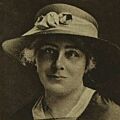Eunice Murray facts for kids
Eunice Guthrie Murray (born January 21, 1878 – died March 26, 1960) was an important Scottish activist. She fought for women's right to vote and was also a writer. She made history as the only Scottish woman to run in the first election where women could vote in 1918.
Contents
Early Life and Education
Eunice Murray was born in Cardross, Scotland. Her parents, David Murray and Frances Porter Stoddard, were from America. They were both strong supporters of ending slavery. Her father was also a well-known lawyer.
Both of Eunice's parents believed in equal rights for women. Eunice went to St Leonards School. After finishing school, she volunteered for the League of Pity, helping those in need.
Fighting for Women's Rights
In 1908, Eunice joined the Women's Freedom League. This group worked to get women the right to vote. She quickly became the secretary for the league across all of Scotland, outside of the main cities.
She became a key leader in Glasgow. By 1913, she was the president of the league's Scottish Council. Eunice did not agree with the methods of another group, the Women's Social and Political Union (WSPU). She felt their approach was not democratic.
In November 1913, Eunice was arrested. This happened after she spoke to a crowd outside Downing Street in London. She had just attended a big meeting in Budapest about women's voting rights. Eunice believed that the government's actions caused some women's groups to become more forceful.
Even when the WSPU stopped their more forceful actions during World War I, Eunice continued her work. In September 1917, she led a meeting of the Scottish Council of the Women's Freedom League. They discussed their peaceful efforts and planned to raise awareness about the upcoming 'Representation of the People' Bill. This bill would finally give many women the right to vote.
War Work and First Election
During World War I, Eunice Murray helped with the war effort. She worked at a munitions factory, William Beardmore and Company, making supplies for the war. She also handled important secret business.
Despite her busy schedule, she found time to write her first novel, The Hidden Tragedy. In 1918, a general election was held. This was the first time women could stand for election in the UK. Eunice ran as an independent candidate in Glasgow Bridgeton. She was the only woman in Scotland to run in that election. Although she did not win, her participation was a significant moment in history.
Later Life and Writings
After the war, Eunice continued to write. She wrote a book about her mother, Frances Murray a memoir, in 1920. She also wrote about Scottish women from the past. These books included Scottish Women of Bygone Days (1930) and A Gallery of Scottish Women (1935).
Eunice became very interested in folklore, which is the study of traditional stories and customs. She wrote a book called Scottish Homespun. This book had pictures of dolls wearing traditional Scottish clothes, many of which Eunice had made herself. She strongly believed that Scotland should have a folk museum to preserve its history and traditions.
Eunice also served on the committee for the National Trust for Scotland. She also gave money to help this organization. The National Trust helps protect important places and natural beauty in Scotland. Eunice Murray never married and lived in her family home in Cardross until she passed away in 1960.
Images for kids



